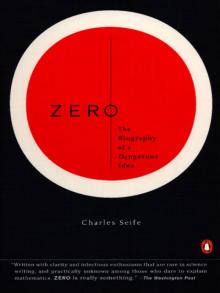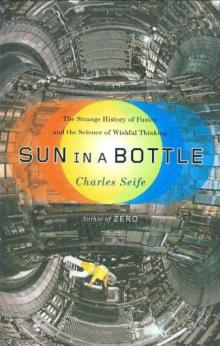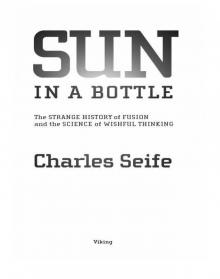Zero Read online
Praise for Zero
“Mathematicians, contrary to popular misconception, are often the most lucid of writers (Bertrand Russell won a Nobel Prize not in mathematics but in literature), and Seife is a welcome example. He writes with an understated charm that takes account of human fear, the mistakes of geniuses and the mind’s grandest ambitions.”
—Atlanta Journal Constitution
“Zero emerges as a daunting intellectual riddle in this fascinating chronicle. With remarkable economy, Seife urges his readers to peer through the zero down into the abyss of absolute emptiness and out into the infinite expanse of space…. Deftly and surely, Seife recounts the historical debates, then swiftly rolls the zero right up to the present day, where he plunges through its perilous opening down into the voracious maw of a black hole, and then out into the deep freeze of an ever cooling cosmos. A must read for every armchair physicist.”
—Booklist (starred review)
“His narrative…shifts smoothly from history and philosophy to science and technology, and his prose displays a gift for making complex ideas clear.”
—The Dallas Morning News
“Seife keeps the tone as light as his subject matter is deep. By book’s end, no reader will dispute Seife’s claim that zero is among the most fertile—and therefore most dangerous—ideas that humanity has devised…Seife’s prose provides readers who struggled through math and science courses a clear window for seeing both the powerful techniques of calculus and the conundrums of modern physics…. In doing so…this entertaining and enlightening book reveals one of the roots of humanity’s deepest uncertainties and greatest insights.”
—Publishers Weekly (starred review)
“Even innumerates…can appreciate the intricate web of conceptual connections Seife illuminates.”
—Boston Globe
“The greater part of this book tells a fascinating human story with skill and wit…we come to appreciate the surprising depth and richness of ‘simple’ concepts such as zero and infinity—and their remarkable links to the religion and culture of earlier civilizations and to present-day science.”
—The Philadelphia Inquirer
“Seife…recounts his story as an accomplished science journalist, standing on the outside to bring clarity to complex ideas…. the crisp explanations are refreshing…straightforward and bright.”
—The New York Times
“Seife has a talent for making the most ball-busting of modern theories…seem fairly lucid and common sensical.”
—Salon
ABOUT THE AUTHOR
Charles Seife, a journalist with Science magazine, has also written for New Scientist, Scientific American, The Economist, Science, Wired UK, The Sciences, and numerous other publications. He holds an M.S. in mathematics from Yale University and his areas of research include probability theory and artificial intelligence. His most recent book is Alpha & Omega. He lives in Washington, D.C.
zero
The Biography of a Dangerous Idea
[CHARLES SEIFE]
Drawings by Matt Zimet
PENGUIN BOOKS
PENGUIN BOOKS
Published by the Penguin Group
Penguin Putnam Inc., 375 Hudson Street,
New York, New York 10014, U.S.A.
Penguin Books Ltd, 27 Wrights Lane, London W8 5TZ, England
Penguin Books Australia Ltd, Ringwood, Victoria, Australia
Penguin Books Canada Ltd, 10 Alcorn Avenue,
Toronto, Ontario, Canada M4V 3B2
Penguin Books (N.Z.) Ltd, 182–190 Wairau Road,
Auckland 10, New Zealand
Penguin Books Ltd, Registered Offices:
Harmondsworth, Middlesex, England
First published in the United States of America by Viking Penguin,
a member of Penguin Putnam Inc. 2000
Published in Penguin Books 2000
Copyright © Charles Seife, 2000
All rights reserved
All other drawings by Matt Zimet.
A portion of Chapter 7 appeared in different form as “Running on Empty,” New Scientist, April 25, 1998.
THE LIBRARY OF CONGRESS HAS CATALOGED
THE HARDCOVER EDITION AS FOLLOWS:
Seife, Charles.
Zero: the biography of a number/Charles Seife.
p. cm.
Includes bibliographical references.
ISBN: 9-781-1011-9960-2
1. Zero (The number) I. Title.
QA141.S45 2000
511.2'11—dc21 99–36693
Except in the United States of America, this book is sold subject to the condition that it shall not, by way of trade or otherwise, be lent, re-sold, hired out, or otherwise circulated without the publisher’s prior consent in any form of binding or cover other than that in which it is published and without a similar condition including this condition being imposed on the subsequent purchaser.
Contents
Chapter 0 Null and Void
Chapter 1 Nothing Doing
The Origin of Zero
Chapter 2 Nothing Comes of Nothing
The West Rejects Zero
Chapter 3 Nothing Ventured
Zero Goes East
Chapter 4 The Infinite God of Nothing
The Theology of Zero
Chapter 5 Infinite Zeros and Infidel Mathematicians
Zero and the Scientific Revolution
Chapter 6 Infinity’s Twin
The Infinite Nature of Zero
Chapter 7 Absolute Zeros
The Physics of Zero
Chapter 8 Zero Hour at Ground Zero
Zero at the Edge of Space and Time
Chapter 9 Zero’s Final Victory
End Time
Appendix A Animal, Vegetable, or Minister?
Appendix B The Golden Ratio
Appendix C The Modern Definition of a Derivative
Appendix D Cantor Enumerates the Rational Numbers
Appendix E Make Your Own Wormhole Time Machine
Selected Bibliography
Acknowledgments
Index
zero
Chapter 0
Null and Void
Zero hit the USS Yorktown like a torpedo.
On September 21, 1997, while cruising off the coast of Virginia, the billion-dollar missile cruiser shuddered to a halt. Yorktown was dead in the water.
Warships are designed to withstand the strike of a torpedo or the blast of a mine. Though it was armored against weapons, nobody had thought to defend the Yorktown from zero. It was a grave mistake.
The Yorktown’s computers had just received new software that was controlling the engines. Unfortunately, nobody had spotted the time bomb lurking in the code, a zero that engineers were supposed to remove while installing the software. But for one reason or another, the zero was overlooked, and it stayed hidden in the code. Hidden, that is, until the software called it into memory—and choked.
When the Yorktown’s computer system tried to divide by zero, 80,000 horsepower instantly became worthless. It took nearly three hours to attach emergency controls to the engines, and the Yorktown then limped into port. Engineers spent two days getting rid of the zero, repairing the engines, and putting the Yorktown back into fighting trim.
No other number can do such damage. Computer failures like the one that struck the Yorktown are just a faint shadow of the power of zero. Cultures girded themselves against zero, and philosophies crumbled under its influence, for zero is different from the other numbers. It provides a glimpse of the ineffable and the infinite. This is why it has been feared and hated—and outlawed.
This is the story of zero, from its birth in ancient times to its growth and nourishment in the East, its struggle for acceptance in Europe, its ascendance in the West, and
its ever-present threat to modern physics. It is the story of the people who battled over the meaning of the mysterious number—the scholars and mystics, the scientists and clergymen—who each tried to understand zero. It is the story of the Western world’s attempts to shield itself unsuccessfully (and sometimes violently) from an Eastern idea. And it is a history of the paradoxes posed by an innocent-looking number, rattling even this century’s brightest minds and threatening to unravel the whole framework of scientific thought.
Zero is powerful because it is infinity’s twin. They are equal and opposite, yin and yang. They are equally paradoxical and troubling. The biggest questions in science and religion are about nothingness and eternity, the void and the infinite, zero and infinity. The clashes over zero were the battles that shook the foundations of philosophy, of science, of mathematics, and of religion. Underneath every revolution lay a zero—and an infinity.
Zero was at the heart of the battle between East and West. Zero was at the center of the struggle between religion and science. Zero became the language of nature and the most important tool in mathematics. And the most profound problems in physics—the dark core of a black hole and the brilliant flash of the big bang—are struggles to defeat zero.
Yet through all its history, despite the rejection and the exile, zero has always defeated those who opposed it. Humanity could never force zero to fit its philosophies. Instead, zero shaped humanity’s view of the universe—and of God.
Chapter 1
Nothing Doing
[ THE ORIGIN OF ZERO ]
There was neither non-existence nor existence then; there was neither the realm of space nor the sky which is beyond. What stirred? Where?
—THE RIG VEDA
The story of zero is an ancient one. Its roots stretch back to the dawn of mathematics, in the time thousands of years before the first civilization, long before humans could read and write. But as natural as zero seems to us today, for ancient peoples zero was a foreign—and frightening—idea. An Eastern concept, born in the Fertile Crescent a few centuries before the birth of Christ, zero not only evoked images of a primal void, it also had dangerous mathematical properties. Within zero there is the power to shatter the framework of logic.
The beginnings of mathematical thought were found in the desire to count sheep and in the need to keep track of property and of the passage of time. None of these tasks requires zero; civilizations functioned perfectly well for millennia before its discovery. Indeed, zero was so abhorrent to some cultures that they chose to live without it.
Life without Zero
The point about zero is that we do not need to use it in the operations of daily life. No one goes out to buy zero fish. It is in a way the most civilized of all the cardinals, and its use is only forced on us by the needs of cultivated modes of thought.
—ALFRED NORTH WHITEHEAD
It’s difficult for a modern person to imagine a life without zero, just as it’s hard to imagine life without the number seven or the number 31. However, there was a time where there was no zero—just as there was no seven and 31. It was before the beginning of history, so paleontologists have had to piece together the tale of the birth of mathematics from bits of stone and bone. From these fragments, researchers discovered that Stone Age mathematicians were a bit more rugged than modern ones. Instead of blackboards, they used wolves.
A key clue to the nature of Stone Age mathematics was unearthed in the late 1930s when archaeologist Karl Absolom, sifting through Czechoslovakian dirt, uncovered a 30,000-year-old wolf bone with a series of notches carved into it. Nobody knows whether Gog the caveman had used the bone to count the deer he killed, the paintings he drew, or the days he had gone without a bath, but it is pretty clear that early humans were counting something.
A wolf bone was the Stone Age equivalent of a supercomputer. Gog’s ancestors couldn’t even count up to two, and they certainly did not need zero. In the very beginning of mathematics, it seems that people could only distinguish between one and many. A caveman owned one spearhead or many spear-heads; he had eaten one crushed lizard or many crushed lizards. There was no way to express any quantities other than one and many. Over time, primitive languages evolved to distinguish between one, two, and many, and eventually one, two, three, many, but didn’t have terms for higher numbers. Some languages still have this shortcoming. The Siriona Indians of Bolivia and the Brazilian Yanoama people don’t have words for anything larger than three; instead, these two tribes use the words for “many” or “much.”
Thanks to the very nature of numbers—they can be added together to create new ones—the number system didn’t stop at three. After a while, clever tribesmen began to string number-words in a row to yield more numbers. The languages currently used by the Bacairi and the Bororo peoples of Brazil show this process in action; they have number systems that go “one,” “two,” “two and one,” “two and two,” “two and two and one,” and so forth. These people count by twos. Mathematicians call this a binary system.
Few people count by twos like the Bacairi and Bororo. The old wolf bone seems to be more typical of ancient counting systems. Gog’s wolf bone had 55 little notches in it, arranged into groups of five; there was a second notch after the first 25 marks. It looks suspiciously as if Gog was counting by fives, and then tallied groups in bunches of five. This makes a lot of sense. It is a lot faster to tally the number of marks in groups than it is to count them one by one. Modern mathematicians would say that Gog, the wolf carver, used a five-based or quinary counting system.
But why five? Deep down, it’s an arbitrary decision. If Gog put his tallies in groups of four, and counted in groups of four and 16, his number system would have worked just as well, as would groups of six and 36. The groupings don’t affect the number of marks on the bone; they only affect the way that Gog tallies them up in the end—and he will always get the same answer no matter how he counts them. However, Gog preferred to count in groups of five rather than four, and people all over the world shared Gog’s preference. It was an accident of nature that gave humans five fingers on each hand, and because of this accident, five seemed to be a favorite base system across many cultures. The early Greeks, for instance, used the word “fiving” to describe the process of tallying.
Even in the South American binary counting schemes, linguists see the beginnings of a quinary system. A different phrase in Bororo for “two and two and one” is “this is my hand all together.” Apparently, ancient peoples liked to count with their body parts, and five (a hand), ten (both hands), and twenty (both hands and both feet) were the favorites. In English, eleven and twelve seem to be derived from “one over [ten]” and “two over [ten],” while thirteen, fourteen, fifteen, and so on are contractions of “three and ten,” “four and ten,” and “five and ten.” From this, linguists conclude that ten was the basic unit in the Germanic protolanguages that English came from, and thus those people used a base-10 number system. On the other hand, in French, eighty is quatre-vingts (four twenties), and ninety is quatre-vingt-dix (four twenties and ten). This may mean that the people who lived in what is now France used a base-20 or vigesimal number system. Numbers like seven and 31 belonged to all of these systems, quinary, decimal, and vigesimal alike. However, none of these systems had a name for zero. The concept simply did not exist.
You never need to keep track of zero sheep or tally your zero children. Instead of “We have zero bananas,” the grocer says, “We have no bananas.” You don’t have to have a number to express the lack of something, and it didn’t occur to anybody to assign a symbol to the absence of objects. This is why people got along without zero for so long. It simply wasn’t needed. Zero just never came up.
In fact, knowing about numbers at all was quite an ability in prehistoric times. Simply being able to count was considered a talent as mystical and arcane as casting spells and calling the gods by name. In the Egyptian Book of the Dead, when a dead soul is challenged by Aqen, the ferryman who conveys
departed spirits across a river in the netherworld, Aqen refuses to allow anyone aboard “who does not know the number of his fingers.” The soul must then recite a counting rhyme to tally his fingers, satisfying the ferryman. (The Greek ferryman, on the other hand, wanted money, which was stowed under the dead person’s tongue.)
Though counting abilities were rare in the ancient world, numbers and the fundamentals of counting always developed before writing and reading. When early civilizations started pressing reeds to clay tablets, carving figures in stone, and daubing ink on parchment and on papyrus, number systems had already been well-established. Transcribing the oral number system into written form was a simple task: people just needed to figure out a coding method whereby scribes could set the numbers down in a more permanent form. (Some societies even found a way to do this before they discovered writing. The illiterate Incas, for one, used the quipu, a string of colored, knotted cords, to record calculations.)
The first scribes wrote down numbers in a way that matched their base system, and predictably, did it in the most concise way they could think of. Society had progressed since the time of Gog. Instead of making little groups of marks over and over, the scribes created symbols for each type of grouping; in a quinary system, a scribe might make a certain mark for one, a different symbol for a group of five, yet another mark for a group of 25, and so forth.

 Zero
Zero Sun in a Bottle_The Strange History of Fusion and the Science of Wishful Thinking
Sun in a Bottle_The Strange History of Fusion and the Science of Wishful Thinking Sun in a Bottle
Sun in a Bottle